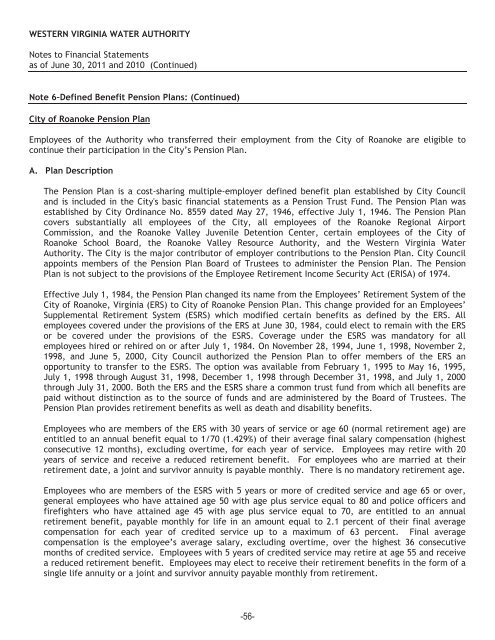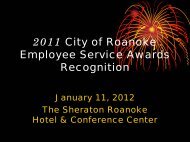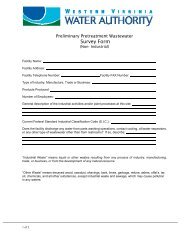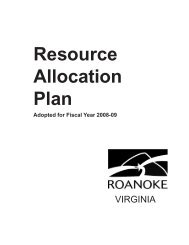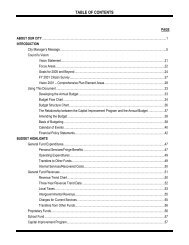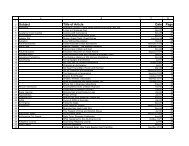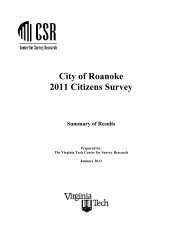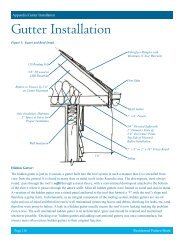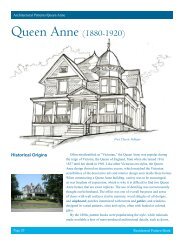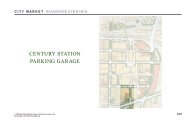Comprehensive Annual Financial Report June 30, 2011 - Western ...
Comprehensive Annual Financial Report June 30, 2011 - Western ...
Comprehensive Annual Financial Report June 30, 2011 - Western ...
You also want an ePaper? Increase the reach of your titles
YUMPU automatically turns print PDFs into web optimized ePapers that Google loves.
WESTERN VIRGINIA WATER AUTHORITY<br />
Notes to <strong>Financial</strong> Statements<br />
as of <strong>June</strong> <strong>30</strong>, <strong>2011</strong> and 2010 (Continued)<br />
Note 6–Defined Benefit Pension Plans: (Continued)<br />
City of Roanoke Pension Plan<br />
Employees of the Authority who transferred their employment from the City of Roanoke are eligible to<br />
continue their participation in the City’s Pension Plan.<br />
A. Plan Description<br />
The Pension Plan is a cost-sharing multiple-employer defined benefit plan established by City Council<br />
and is included in the City's basic financial statements as a Pension Trust Fund. The Pension Plan was<br />
established by City Ordinance No. 8559 dated May 27, 1946, effective July 1, 1946. The Pension Plan<br />
covers substantially all employees of the City, all employees of the Roanoke Regional Airport<br />
Commission, and the Roanoke Valley Juvenile Detention Center, certain employees of the City of<br />
Roanoke School Board, the Roanoke Valley Resource Authority, and the <strong>Western</strong> Virginia Water<br />
Authority. The City is the major contributor of employer contributions to the Pension Plan. City Council<br />
appoints members of the Pension Plan Board of Trustees to administer the Pension Plan. The Pension<br />
Plan is not subject to the provisions of the Employee Retirement Income Security Act (ERISA) of 1974.<br />
Effective July 1, 1984, the Pension Plan changed its name from the Employees’ Retirement System of the<br />
City of Roanoke, Virginia (ERS) to City of Roanoke Pension Plan. This change provided for an Employees’<br />
Supplemental Retirement System (ESRS) which modified certain benefits as defined by the ERS. All<br />
employees covered under the provisions of the ERS at <strong>June</strong> <strong>30</strong>, 1984, could elect to remain with the ERS<br />
or be covered under the provisions of the ESRS. Coverage under the ESRS was mandatory for all<br />
employees hired or rehired on or after July 1, 1984. On November 28, 1994, <strong>June</strong> 1, 1998, November 2,<br />
1998, and <strong>June</strong> 5, 2000, City Council authorized the Pension Plan to offer members of the ERS an<br />
opportunity to transfer to the ESRS. The option was available from February 1, 1995 to May 16, 1995,<br />
July 1, 1998 through August 31, 1998, December 1, 1998 through December 31, 1998, and July 1, 2000<br />
through July 31, 2000. Both the ERS and the ESRS share a common trust fund from which all benefits are<br />
paid without distinction as to the source of funds and are administered by the Board of Trustees. The<br />
Pension Plan provides retirement benefits as well as death and disability benefits.<br />
Employees who are members of the ERS with <strong>30</strong> years of service or age 60 (normal retirement age) are<br />
entitled to an annual benefit equal to 1/70 (1.429%) of their average final salary compensation (highest<br />
consecutive 12 months), excluding overtime, for each year of service. Employees may retire with 20<br />
years of service and receive a reduced retirement benefit. For employees who are married at their<br />
retirement date, a joint and survivor annuity is payable monthly. There is no mandatory retirement age.<br />
Employees who are members of the ESRS with 5 years or more of credited service and age 65 or over,<br />
general employees who have attained age 50 with age plus service equal to 80 and police officers and<br />
firefighters who have attained age 45 with age plus service equal to 70, are entitled to an annual<br />
retirement benefit, payable monthly for life in an amount equal to 2.1 percent of their final average<br />
compensation for each year of credited service up to a maximum of 63 percent. Final average<br />
compensation is the employee’s average salary, excluding overtime, over the highest 36 consecutive<br />
months of credited service. Employees with 5 years of credited service may retire at age 55 and receive<br />
a reduced retirement benefit. Employees may elect to receive their retirement benefits in the form of a<br />
single life annuity or a joint and survivor annuity payable monthly from retirement.<br />
-56-


